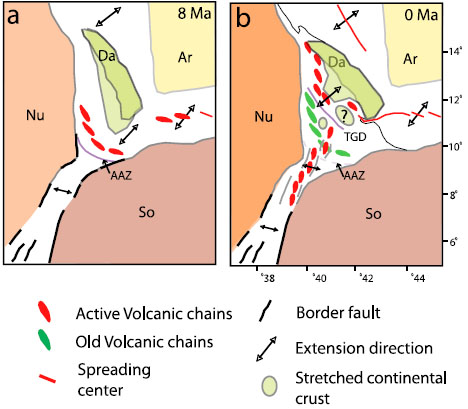The nature of the crust beneath the Afar triple junction: Evidence from receiver functions, Hammond et al 2011
Non-technical summary
This paper looks at the nature of the Earth's crust beneath the Afar depression, Ethiopia, using evidence from receiver functions. A receiver function is produced by processing information on how seismic waves, generated by earthquakes, interact with sharp boundaries (such as the base of the crust) beneath a seismometer.
The thickness of the crust varies from ~16km in the northern rift to ~45km beneath the western plateau and contains significant amounts of partially melted rock in the lower crust, particularly beneath regions of thinner crust. The regions of this melt are concentrated along current and past plate boundaries. The large amount of partial melt in these locations supports the idea that magma injection from the lower crust into the upper crust plays an important role in late stage rifting. The results shown here are some of the most anomalous on the planet, showing that large amounts of molten rock are present beneath almost all of Afar.
The Afar depression is part of a triple-junction where three plates meet (African, Somalian and Arabian plates) and is a region where the final stages of continental breakup can be studied. What we show is that in fact much of Afar retains a small amount of continental crust in the upper crust. Also, by mapping out the crustal structure of past and present plate boundaries it can be seen that the Red Sea Rift (between the African and Arabian plates) has migrated eastwards over the last 8 million years ago. This may have occurred in a series of jumps which have left small blocks of thicker continental crust within the more oceanic crust of the Afar depression.

Figure 1: Cartoon models of the Afar depression 8 million years ago and at the present day. AAZ acruate accommodation zone, TGD Tendaho-Gob'a discontinuity
Full paper (PDF file)
